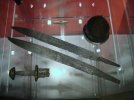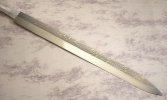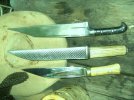The seax was originally a belt/utility knife. Swords were extremely rare and expensive in the 5th-11th century because of a lack of quality ores and lack of skilled weaponsmiths. The seax was often pressed into service as a backup weapon because swords of the day were often brittle and the edges wore down quickly in combat. As viking raids became more prevalent, the seax grew into a singled-edged short sword and was pressed into service with a spear and shield. The seax's singled-edged design allowed for a thicker spine and a more durable weapon.
-
The BladeForums.com 2024 Traditional Knife is available! Price is $250 ea (shipped within CONUS).
Order here: https://www.bladeforums.com/help/2024-traditional/
You are using an out of date browser. It may not display this or other websites correctly.
You should upgrade or use an alternative browser.
You should upgrade or use an alternative browser.
The Seax from the Blem Box Review
- Thread starter sweetcostarica
- Start date
- Status
- Not open for further replies.
The seax was originally a belt/utility knife. Swords were extremely rare and expensive in the 5th-11th century because of a lack of quality ores and lack of skilled weaponsmiths. The seax was often pressed into service as a backup weapon because swords of the day were often brittle and the edges wore down quickly in combat. As viking raids became more prevalent, the seax grew into a singled-edged short sword and was pressed into service with a spear and shield. The seax's singled-edged design allowed for a thicker spine and a more durable weapon.
Wait. You're talking as if this started in Europe instead of starting around Nepal/India area?
- Joined
- Feb 8, 2012
- Messages
- 82
Wikipedia had some interesting info on the subject.
http://en.wikipedia.org/wiki/Seax
"Another typical form of the seax is the so-called broken-back style seax. These seaxes have a sharp angled transition between the back section of the blade and the point, the latter generally forming 1/3 to 3/5 of the blade length. These seaxes exist both in long seax variety (edge and back parallel) and in smaller blades of various lengths (blade expanding first, then narrowing towards the tip after the kink). They occurred mostly in the UK and Ireland, with some examples in Germany around 8th-11th century. "
http://en.wikipedia.org/wiki/Seax
"Another typical form of the seax is the so-called broken-back style seax. These seaxes have a sharp angled transition between the back section of the blade and the point, the latter generally forming 1/3 to 3/5 of the blade length. These seaxes exist both in long seax variety (edge and back parallel) and in smaller blades of various lengths (blade expanding first, then narrowing towards the tip after the kink). They occurred mostly in the UK and Ireland, with some examples in Germany around 8th-11th century. "
sweetcostarica
BANNED
- Joined
- Jan 18, 2012
- Messages
- 619
Found a link to some outstanding Long Seaxes (also called Langsax, Scramasax) here:
http://www.knivesbynick.co.uk/weapons_axes.htm
The Seaxes are made to the customer's specifications and wishes, just like they were in history.
Thanks Nils Georg for bringing up the longer versions of the Seax. I am thinking now of getting one to keep above the fireplace.


Photo on left are two Dutch long saxes, 8th century IIRC (from Jeroen Zuiderwijk).
Newly made Seax on right by J.Arthur Loose
http://www.knivesbynick.co.uk/weapons_axes.htm
The Seaxes are made to the customer's specifications and wishes, just like they were in history.
Thanks Nils Georg for bringing up the longer versions of the Seax. I am thinking now of getting one to keep above the fireplace.


Photo on left are two Dutch long saxes, 8th century IIRC (from Jeroen Zuiderwijk).
Newly made Seax on right by J.Arthur Loose
Last edited:
The Seax has a history of being used in Scandanavia, but a broken back Seax like yours, was carried in England by who else?, the Saxons. I have a 20" one and a 26" one I'm making in the basement. By the way, the Seax was carried sideways in the front of the person, with the edge up. A shorter one like you have, was also called a Scramaseax when used for eating. They were an everyday everything knife.
sweetcostarica
BANNED
- Joined
- Jan 18, 2012
- Messages
- 619
Good info Kalis of Minnesota. I envy you because you can make your own Seax :thumbup:.

Picture: SeaxThree by greenwoods in Blade Forum
I intend to test your statement out in the woods of Alaska this Spring/Summer. Will use it like a belt knife and see how good this pattern is at cutting rope, chopping small things, splitting wood, etc. Stay tuned.A shorter one like you have, was also called a Scramaseax when used for eating. They were an everyday everything knife.

Picture: SeaxThree by greenwoods in Blade Forum
One of the things about the Seax is that most were very well used when lost or, apparently chucked into bogs for some reason. As such, it has always been difficult to ascertain original blade shapes. Some Seaxs were sharpened to slivers as they were probably passed down over the generations. German and Danish ones had a leaf shaped blade generally. Scandinavian ones varied. The one that looks like a bowie knife with very little belly is the British Isles version...the Broken Back Seax.
- Status
- Not open for further replies.
